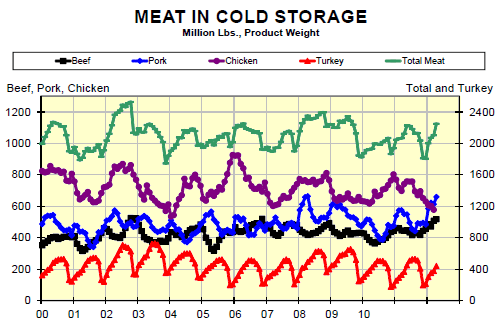



CME: Little to No Good News for Meat Sectors
US - USDA’S monthly Cold Storage report was released today and it contained little good news for the meat and poultry businesses and was particularly ugly for the pork sector, write Steve Meyer and Len Steiner.The chart below shows inventory levels for the four major meat species as well as the total.

The table on page 2 (please see link below) contains all of USDA’s data regarding the amounts of the various cuts in the US freezers on 30 April. Some important features of the report are:
- Total frozen meat and poultry inventories stood at 2.249 millin
pounds on April 30. That is 5.9 per cent larger than last year and
7.5 per cent larger than on March 31. It is also the largest stock of
frozen meat and poultry at the end of any month since August
2009. YTD meat and poultry production is DOWN 2.3 per cent.
- The total inventory of pork, at 659.532 million pounds is the
second largest on record. It falls just short of the 663.443 million
pounds that was in freezers at the end of April 2008. This
year’s April 30 inventory is 20.1 per cent higher than last year and
8.1 per cent higher than last month.
- Hams are the largest contributor to the grown in frozen pork
stocks, coming in 46 per cent higher than last year and 40.6 per cent higher
than last month. There are 35.6 million more pounds of hams
in U.S. freezers than one year ago — and 32.5 million more
than last month! Hams have been a challenge all winter and
spring after the holidays passed with significant volume still on
hand. It doesn’t appear that we are very near working through
the backlog yet.
- Bellies were the second big contributor to freezer stock growth,
coming in 40.6 per cent higher than last year and 13.2 per cent higher than
last month. That 40.6 per cent means that there are 21.6 million more
pounds of bellies available this year.
- Based on weekly data, April 30 pork stocks amounted to
roughly 36 per cent of April pork production. That is the highest percentage
of monthly production in month-end cold storage since
April 2000.
- Chicken inventories grew by 5.6 per cent in April but remained 18.2 per cent
lower than one year ago. April stocks are the second lowest
(to March) since March 2007. Wing inventories are barely half
of their April 2011 level but did increase by 10.3 per cent last month
— maybe those prices are getting a bit too high to keep them
moving? Stocks of breasts and breast meat fell to 119.97 million
pounds, 18 per cent lower than last year and 2.7 per cent lower than last
month. This is the lowest level of breast meat in freezers since
November 2010. The only hiccup for chicken was a buildup of
leg products in April with drumstick, leg, leg quarter and thigh/
thigh quarter stocks growing by 19.5 million pounds or 18.7 per cent.
- Total beef stocks, at 517.5 million pounds, were 16.8 per cent larger
than last year and 2.9 per cent larger than last month. Those percentage
increases were, to a great degree, equally shared between
boneless beef and beef cuts. The April 30 total was the largest
since November 2006 and marks only the 6th time that month-monthend
beef inventories have exceeded 500 million pounds. It
should be noted that monthly beef output in April 2011, based
on weekly data, will be about 2 billion pounds. It was 2.2 billion
in November 2006 and in the range of 2.2 to 2.5 billion pounds
in the fall of 2002 when beef stocks were also over 500 million.
This year’s stocks represent a larger share of production than
did similar levels in the past.
- Finally, turkey inventories are sharply higher this year. April’s 438.5 million pounds was 20.3 per cent larger than last year and 16.9 per cent larger than last month. As can be seen in the chart above, monthly gains in turkey stocks through June or July are the absolute norm as producers and end-users build the inventories necessary to handle holiday sales. This year is no different except that the pace of the buildup is considerably faster than the past two years. While whole birds, as expected, counted for the largest volume of April’s increase, every other cut category except mechanically de-boned turkey saw larger percentage increase relative to last year.
So what does this mean? The data suggest that meat
and poultry movement in April was nothing to shout about. That’s
especially true of pork. That slow spring movement has left
enough product in freezers to perhaps blunt any cash rallies that
could start when hog numbers finally decline this summer — In
history we trust!
When we look at year-on-year changes, we have to be a
bit concerned about beef, whose stocks have increased even
though production has moved lower. If exports remained below
2011 levels in April, these mean beef movement was indeed slow.
Maybe it is time to move away from record-high and near
record-high retail prices long enough to clean up some of these
inventories. Grilling season is here and some aggressive features
could attract a lot of retail traffic and move a lot of product.
Further ReadingYou can view the full report by clicking here. |








